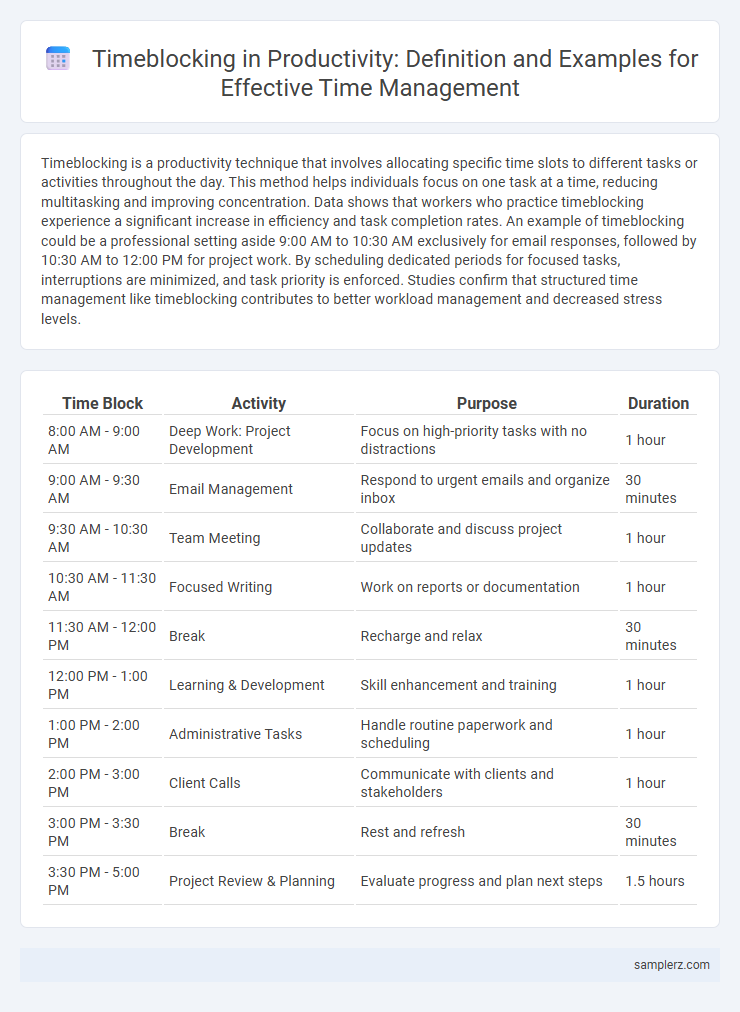Timeblocking is a productivity technique that involves allocating specific time slots to different tasks or activities throughout the day. This method helps individuals focus on one task at a time, reducing multitasking and improving concentration. Data shows that workers who practice timeblocking experience a significant increase in efficiency and task completion rates. An example of timeblocking could be a professional setting aside 9:00 AM to 10:30 AM exclusively for email responses, followed by 10:30 AM to 12:00 PM for project work. By scheduling dedicated periods for focused tasks, interruptions are minimized, and task priority is enforced. Studies confirm that structured time management like timeblocking contributes to better workload management and decreased stress levels.
Table of Comparison
| Time Block | Activity | Purpose | Duration |
|---|---|---|---|
| 8:00 AM - 9:00 AM | Deep Work: Project Development | Focus on high-priority tasks with no distractions | 1 hour |
| 9:00 AM - 9:30 AM | Email Management | Respond to urgent emails and organize inbox | 30 minutes |
| 9:30 AM - 10:30 AM | Team Meeting | Collaborate and discuss project updates | 1 hour |
| 10:30 AM - 11:30 AM | Focused Writing | Work on reports or documentation | 1 hour |
| 11:30 AM - 12:00 PM | Break | Recharge and relax | 30 minutes |
| 12:00 PM - 1:00 PM | Learning & Development | Skill enhancement and training | 1 hour |
| 1:00 PM - 2:00 PM | Administrative Tasks | Handle routine paperwork and scheduling | 1 hour |
| 2:00 PM - 3:00 PM | Client Calls | Communicate with clients and stakeholders | 1 hour |
| 3:00 PM - 3:30 PM | Break | Rest and refresh | 30 minutes |
| 3:30 PM - 5:00 PM | Project Review & Planning | Evaluate progress and plan next steps | 1.5 hours |
What is Timeblocking?
Timeblocking is a productivity technique that involves dividing your day into distinct blocks of time, each dedicated to a specific task or activity. This method helps reduce multitasking and enhances focus by allocating uninterrupted periods for deep work, meetings, or breaks. Effective timeblocking improves time management and increases overall efficiency by ensuring prioritized tasks receive concentrated attention.
Key Benefits of Timeblocking for Productivity
Timeblocking enhances productivity by allocating specific time slots for focused tasks, reducing multitasking and minimizing distractions. This method improves time management, helping individuals meet deadlines efficiently and maintain consistent work momentum. Increased concentration and structured scheduling through timeblocking lead to higher-quality output and reduced stress.
Essential Steps to Start Timeblocking
Timeblocking in productivity involves scheduling specific blocks of time for focused tasks, helping to prevent multitasking and increase efficiency. Essential steps to start timeblocking include identifying priority tasks, allocating fixed time slots for each, and minimizing distractions during these periods to maintain deep focus. Using digital calendars or planners to visualize and commit to these blocks ensures better adherence and time management throughout the day.
Real-World Timeblocking Schedules
Timeblocking enhances productivity by assigning specific time slots to tasks such as emails from 9 to 9:30 AM, project work from 9:30 to 11 AM, and meetings from 11 to noon, creating a structured daily workflow. Companies like Google implement real-world timeblocking schedules to minimize distractions and optimize deep work intervals, increasing employee focus during peak cognitive hours. Personal examples include blocking two-hour sessions for focused writing and 30-minute segments for planning, boosting task completion rates by reducing multitasking and context switching.
Timeblocking vs. Traditional To-Do Lists
Timeblocking enhances productivity by allocating specific time slots for focused tasks, reducing distractions and improving task completion rates. Unlike traditional to-do lists that prioritize task enumeration, timeblocking structures the day around dedicated work periods, enabling clearer priorities and better time management. Studies show timeblocking users experience up to 25% higher productivity compared to those relying solely on conventional to-do lists.
Sample Daily Timeblocking Template
A sample daily timeblocking template segments the workday into dedicated blocks, such as 9-10 AM for email management, 10-11:30 AM for project deep work, and 1-2 PM for meetings. This structured approach minimizes multitasking and enhances focus on individual tasks, boosting overall productivity. Using timeblocking increases task completion rates by creating clear boundaries for activities and reducing distractions.
Best Tools for Effective Timeblocking
Effective timeblocking relies on tools like Google Calendar, Trello, and Microsoft Outlook to schedule focused work periods and minimize distractions. These platforms enable setting clear time slots for tasks, integrating reminders, and tracking progress to enhance productivity. Using features such as color-coded blocks and automated notifications ensures consistent adherence to planned time intervals and boosts workflow efficiency.
Common Timeblocking Mistakes to Avoid
Timeblocking boosts productivity by allocating specific time slots for tasks, but common mistakes like over-scheduling, lack of breaks, and underestimating task duration can reduce its effectiveness. Frequent interruptions and multitasking during blocked periods disrupt focus and lead to inefficiency. Properly estimating time requirements and scheduling buffer periods enhance the benefits of timeblocking.
Timeblocking Success Stories
Timeblocking has dramatically increased productivity for professionals by allocating specific time slots to tasks, such as Elon Musk's use of 5-minute blocks to manage multiple companies efficiently. Cal Newport credits timeblocking for helping him avoid distractions and complete deep work sessions, dramatically boosting output in knowledge work. Companies like Google report that employees who implement timeblocking strategies experience a 30% increase in task completion rates and an overall improvement in work-life balance.
Tips for Maintaining Your Timeblocked Routine
Consistently review and adjust your time blocks to align with shifting priorities and energy levels throughout the day. Use digital calendars with reminders to minimize distractions and reinforce accountability. Incorporate buffer periods between tasks to enhance flexibility while maintaining productivity flow.

example of Timeblocking in productivity Infographic
 samplerz.com
samplerz.com